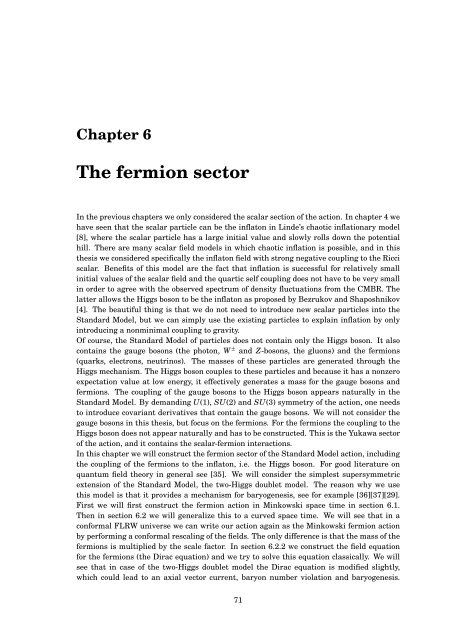Master's Thesis in Theoretical Physics - Universiteit Utrecht
Master's Thesis in Theoretical Physics - Universiteit Utrecht
Master's Thesis in Theoretical Physics - Universiteit Utrecht
You also want an ePaper? Increase the reach of your titles
YUMPU automatically turns print PDFs into web optimized ePapers that Google loves.
Chapter 6The fermion sectorIn the previous chapters we only considered the scalar section of the action. In chapter 4 wehave seen that the scalar particle can be the <strong>in</strong>flaton <strong>in</strong> L<strong>in</strong>de’s chaotic <strong>in</strong>flationary model[8], where the scalar particle has a large <strong>in</strong>itial value and slowly rolls down the potentialhill. There are many scalar field models <strong>in</strong> which chaotic <strong>in</strong>flation is possible, and <strong>in</strong> thisthesis we considered specifically the <strong>in</strong>flaton field with strong negative coupl<strong>in</strong>g to the Ricciscalar. Benefits of this model are the fact that <strong>in</strong>flation is successful for relatively small<strong>in</strong>itial values of the scalar field and the quartic self coupl<strong>in</strong>g does not have to be very small<strong>in</strong> order to agree with the observed spectrum of density fluctuations from the CMBR. Thelatter allows the Higgs boson to be the <strong>in</strong>flaton as proposed by Bezrukov and Shaposhnikov[4]. The beautiful th<strong>in</strong>g is that we do not need to <strong>in</strong>troduce new scalar particles <strong>in</strong>to theStandard Model, but we can simply use the exist<strong>in</strong>g particles to expla<strong>in</strong> <strong>in</strong>flation by only<strong>in</strong>troduc<strong>in</strong>g a nonm<strong>in</strong>imal coupl<strong>in</strong>g to gravity.Of course, the Standard Model of particles does not conta<strong>in</strong> only the Higgs boson. It alsoconta<strong>in</strong>s the gauge bosons (the photon, W ± and Z-bosons, the gluons) and the fermions(quarks, electrons, neutr<strong>in</strong>os). The masses of these particles are generated through theHiggs mechanism. The Higgs boson couples to these particles and because it has a nonzeroexpectation value at low energy, it effectively generates a mass for the gauge bosons andfermions. The coupl<strong>in</strong>g of the gauge bosons to the Higgs boson appears naturally <strong>in</strong> theStandard Model. By demand<strong>in</strong>g U(1), SU(2) and SU(3) symmetry of the action, one needsto <strong>in</strong>troduce covariant derivatives that conta<strong>in</strong> the gauge bosons. We will not consider thegauge bosons <strong>in</strong> this thesis, but focus on the fermions. For the fermions the coupl<strong>in</strong>g to theHiggs boson does not appear naturally and has to be constructed. This is the Yukawa sectorof the action, and it conta<strong>in</strong>s the scalar-fermion <strong>in</strong>teractions.In this chapter we will construct the fermion sector of the Standard Model action, <strong>in</strong>clud<strong>in</strong>gthe coupl<strong>in</strong>g of the fermions to the <strong>in</strong>flaton, i.e. the Higgs boson. For good literature onquantum field theory <strong>in</strong> general see [35]. We will consider the simplest supersymmetricextension of the Standard Model, the two-Higgs doublet model. The reason why we usethis model is that it provides a mechanism for baryogenesis, see for example [36][37][29].First we will first construct the fermion action <strong>in</strong> M<strong>in</strong>kowski space time <strong>in</strong> section 6.1.Then <strong>in</strong> section 6.2 we will generalize this to a curved space time. We will see that <strong>in</strong> aconformal FLRW universe we can write our action aga<strong>in</strong> as the M<strong>in</strong>kowski fermion actionby perform<strong>in</strong>g a conformal rescal<strong>in</strong>g of the fields. The only difference is that the mass of thefermions is multiplied by the scale factor. In section 6.2.2 we construct the field equationfor the fermions (the Dirac equation) and we try to solve this equation classically. We willsee that <strong>in</strong> case of the two-Higgs doublet model the Dirac equation is modified slightly,which could lead to an axial vector current, baryon number violation and baryogenesis.71
















